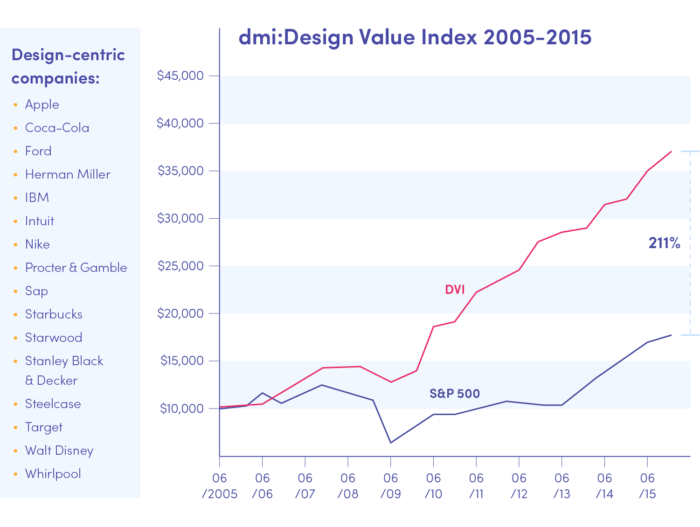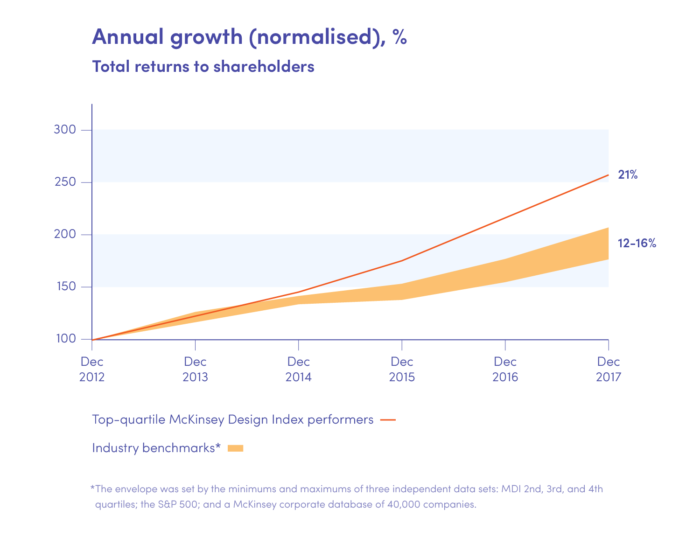In business, time is always money. We want to release the best project powered by the latest tech in the shortest time for the lowest cost. It’s a given.
Another given is that there is always a pressing need for compromise. Perhaps the tech stack doesn’t have to be quite that powerful. Or it’s better to lay back on animated illustrations because buying stock photos is easier. Or you can choose to cut back on user tests because you just know people are going to love what you have to offer.
Design Thinking is a strategy that helps you get the product just right without sacrificing any of its original value and save quite a few zeros in the process. We’re going to look into how Design Thinking can help any company – not only a unicorn startup – meet its core business goals faster.
Design Thinking in a nutshell
Don’t want to spend your entire lunch break digging for details? Here’s what you need to know:
- Products created with Design Thinking in mind are desirable, feasible, and viable; thus they cover every aspect of your strategy.
- By enhancing your corporate strategy with Design Thinking principles you can create a product that is actually needed, cut down the development costs, increase your revenue, and win over more loyal customers.
- Implement the Design Thinking process into your business strategy by following these 5 simple steps: empathise with the customer, define their challenge, ideate the solution to that challenge, build a prototype, and test the outcome.
We’ve completed more than 250 projects by following the Design Thinking approach, so we know it works.
And now it’s time to jump into the specifics.
What is design thinking in business strategy: a quick recap
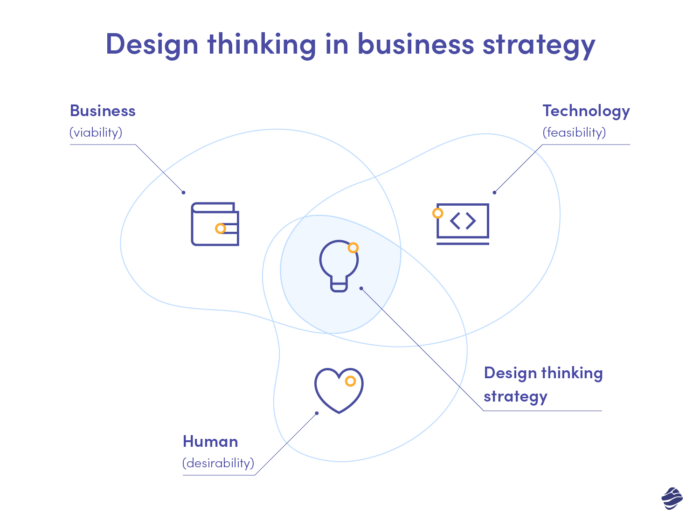
Steve Jobs claimed that design isn’t how something looks, but how it works. Design thinkers take it a step further and say that design is not only how something looks, but also how it works and how much it costs.
At its core, Design Thinking comes down to 5 distinct stages that bring together a problem-solution approach and the most suitable tech for the best cost.
Tim Brown, IDEO
In theory, by following the Design Thinking methodology you create a product that is desirable for customers, feasible in terms of technology, and viable from a business perspective.
Why does the traditional approach to strategy fail?
Traditional approaches to business strategy are not enough in today’s world because they are often based on past performance. However, with the advent of new technologies and changing consumer behaviours, they should no longer be relied upon to predict the future.
In addition, traditional approaches to strategy development often focus on the business’s internal capabilities rather than the user’s needs and preferences. This can lead to solutions that could be more user-friendly and fail to meet the needs of the target audience.
On the other hand, design thinking focuses on the user and seeks to understand their needs and pain points before developing solutions. This approach is more agile and responsive to changes in the market and can lead to innovative solutions that meet the user’s needs.
By using design thinking in product strategy, companies can create user-centred solutions that meet their target audience’s expectations.
How can design thinking help your business in the long term?
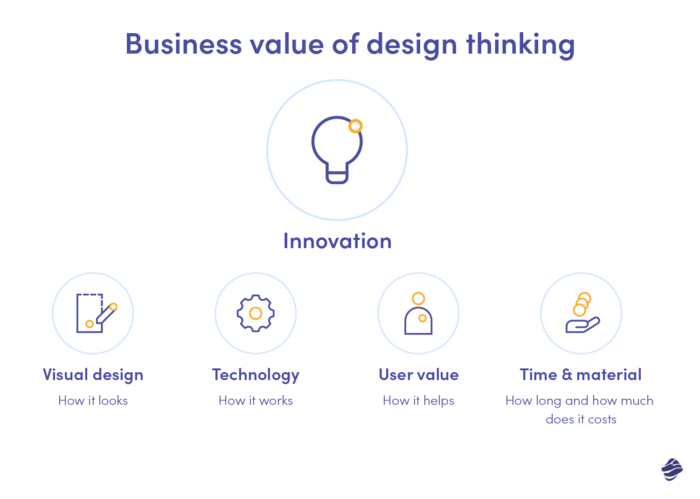
After all, releasing a product is not all there is to it. So much more is happening behind the scenes: market research, budget estimation, marketing campaigns, post-release PR, customer support, app maintenance, and so on.
And you might be surprised to learn that Design Thinking can prove to be just as useful at any of these stages as it is during product development.

But before we jump in, I’d like to underline one more time that Design Thinking is NOT about the product design itself. Instead, think of it as yet another methodology for work organisation and strategic planning.
Business value of design thinking
I am going to skip the obvious “you will have a visually stunning digital product running on a powerful technology”. You can learn more about the product design services we offer once your business strategy is settled.
Here, I want to bring your attention to the “corporate” side of Design Thinking. As it turns out, it can bring quite a few benefits when it comes to your business strategy and long-term plans.
Success is achieved through 5 equally important factors: design, technology, value, time-to-market, and resources invested. Here’s a quick example of how it may look:
Faster revenue growth
When it comes to long-term business planning, nothing matters quite as much as potential revenue. There are two ways in which Design Thinking helps you earn more with less:
- You are far more likely to succeed if you try to address your challenges one at a time instead of producing a holistic non-negotiable 3-year plan as an ultimate remedy for all your problems
- It is impossible to separate the actual usability of the product from the Design Thinking process. And as the research shows, design-centric companies’ ROI grows faster.
Design Thinking encourages you to put users first. That means a lot of things, like rapid changes in the social environment or a shift of the general public’s interest. Design Thinking allows you to react, rather than sit and wonder what is going to happen to your business strategy now that the world is burning.
Such a proactive approach is exactly what causes the numbers to rise and your profits to multiply.
Reduced expenses
Another one of the most serious benefits of applying the Design Thinking approach to your business strategy is that it can help you significantly cut costs.
This is mainly achieved thanks to the same problem-solution model that allows you to generate higher revenue. Instead of searching (and paying) for a one-size-fits-all solution, Design Thinking motivates you to break your main challenge into several smaller ones and address them individually.
As a result, you don’t have to pay for the features, technologies, marketing strategies, or industry-leading reports that just don’t apply in your unique case. It’s one of the reasons why we are so dedicated to custom app development here at Miquido. Every product is unique because every challenge is unique. That’s why the solutions need to be unique as well.
More loyal customers
User retention can be a big problem for some businesses. There are numerous strategies on how to increase your user retention rates, but at the end of the day they all come down to one common variable: you need to give people something they actually need.
While having an engaging app with a modern design, a powerful engine, and an intuitive interface would definitely help your case, Design Thinking allows you to really dig into the core of your clients’ desires.
As McKinsey’s report shows, investing in design-centred solutions once again pays off here. A returning customer is a happy customer. And a happy customer is likely to recommend your app, purchase another product from the same vendor, or, eventually, to even become your partner.
So how does Design Thinking help you make your clients a little bit happier? For starters, this framework makes their best interests your top priority. Before you do as much as think of the colours you’d like for your future digital product, you must carefully analyse your target audience, pinpoint their daily struggles, and put your entire mental effort into providing a solution.
That’s Design Thinking 101:
The product comes as a response to an existing issue.
What lies in the roots of your idea? Why did you come up with it? If the answer is anywhere near “to make a large profit” – I’m afraid you may not be ready for a Design-Thinking-powered business strategy.
But as long as your solution comes from a goal to help, improve, or support – you’ve got yourself a recipe that will get your customers to come back again and again.
How to use design thinking in business
There are 5 steps to every Design Thinking process:
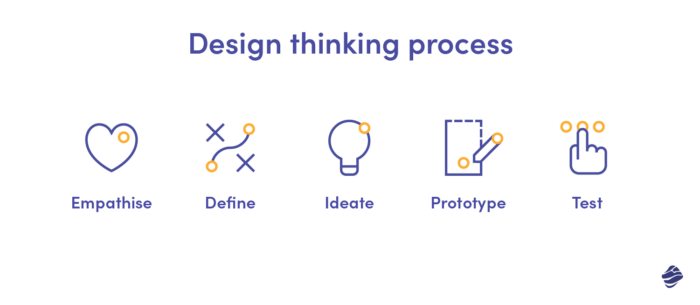
It’s proven to be so successful that since 2011 numerous software development companies, branding agencies, and advertising firms have adopted Design Thinking as their go-to project management methodology.
But how does it translate into strategic planning, when the time comes for achieving business models and goals and ensuring stakeholder satisfaction? Frankly, there are hundreds of ways you could approach it.
Here are some examples of the core differences between Design Thinking as a project management methodology and Design Thinking as a business strategy:
| Product Management | Business Planning | |
|---|---|---|
| Empathise | What problem of your clients do you want your product to solve? E.g. An app for healthy meal planning helps users to improve their diets without seeing a professional or counting calories | What problem of your clients do you want your business to solve? E.g. Your business promotes a healthy lifestyle that goes beyond a balanced diet, that’s just the starting point for you |
| Define | Which specific features should your product have to deliver the highest user satisfaction? E.g. The app should allow users to select their favourite products, edit pre-made plans, analyse user data, and make forecasts accordingly. | Which specific goals should your business have to achieve your mission? E.g. Healthy lifestyle includes good nutrition but also can be affected by the quality of sleep, the amount of exercise, or the overall health of an individual |
| Ideate | How should the product work in order to address the challenge in the most user-friendly way? E.g. Developing core UX & UI concepts for the app | What should the product(s) be in order to address the challenge in the most user-friendly way? E.g. Deciding that the best way to reach your goal would be to release 3 separate products for nutrition, sleep management, and exercise |
| Prototype | Creating a clickable model of the product to see it in action E.g. Your product team prepares the prototype ready for user testing | Creating a short-term strategy to see it in action E.g. You decide to focus on nutrition as the first element of a healthy lifestyle and dedicate your strategy to it for the next 3 months |
| Test | See how real users interact with your product and draw conclusions for improvement E.g. Nobody seems to care about the AI chatbot you wanted to implement so badly, so you decide to remove it from the app | See how your strategy is performing in the real world and draw conclusions for improvement E.g. You discover that the market is oversaturated with nutrition apps and decide to focus on sleep management instead |
How do you create a Design Strategy?
Design thinking provides an alternative approach to strategy development that is more responsive to change. This approach is based on a human-centred design process that seeks to understand the needs and preferences of users before developing solutions.
Design thinking in product strategy involves several steps that build on each other to create a successful plan.
Step 1: Dialogue
The first step in using design thinking to create a product strategy is to engage in dialogue with users. This involves understanding their needs and desires and any challenges or pain points they are experiencing. In this phase, asking open-ended questions and engaging in active listening is essential. This will help you to gain a deep understanding of the user’s perspective and will allow you to identify areas where your product can provide value.
Step 2: Vision
Once you have a deep understanding of the user’s needs, it is crucial to create a vision for the product. This involves envisioning how the product will meet the user’s needs uniquely and innovatively. Engaging in divergent thinking and generating a wide range of ideas is crucial. It is also essential to consider the competitive landscape and how your product can differentiate itself from existing solutions.
Step 3: Explore
The next step is to explore potential solutions in greater detail. This involves prototyping and testing to validate ideas and identify potential issues or challenges. It is worth engaging in rapid prototyping and iterating quickly, using user feedback to refine and improve the product.
Step 4: Create
Once you have identified a solution that meets the user’s needs, it is time to create the product. This involves developing a detailed plan for implementation, including timelines, resource allocation, and budget. Remember to engage in collaborative problem-solving and engage with all stakeholders to ensure that everyone is aligned with the vision and objectives of the product.
Step 5: Implement
The final step in the process is to implement the product strategy. This involves launching the product, monitoring its performance, and making adjustments as necessary. Engaging in ongoing feedback loops with users and stakeholders is vital to ensure that the product continues to meet their needs over time.
Strategy Design use cases
Design thinking is a powerful approach that can be used to create innovative and user-centred solutions across a wide range of industries. It’s all about understanding people’s needs, behaviours, and emotions to create products and experiences that truly resonate with them.
Apple
One great example of design thinking in action is the iPhone. Apple revolutionised the mobile phone industry by creating an intuitive, user-friendly, and visually stunning device. From the touchscreen interface to the app store, every aspect of the iPhone was designed with the user in mind, resulting in a product that millions of people love and use every day.
IDEO
Another example of design thinking at work is IDEO’s redesign of the hospital gown. The traditional hospital gown was uncomfortable, unflattering, and provided little dignity for patients. IDEO used empathy and creativity to create a new gown that was comfortable, functional, and even stylish. The new design includes pockets for personal items, openings for medical equipment, and an overall look and feel that helps preserve the patient’s dignity.
Airbnb
Airbnb is another excellent example of design thinking in action. By focusing on the needs of both hosts and guests, the company created a platform that disrupted the traditional hotel industry. By understanding the needs of travellers and homeowners, Airbnb developed a user-friendly platform that provided value to both parties, resulting in a successful and innovative business model.
Warby Parker
Warby Parker is a company that disrupted the traditional eyewear industry by creating a customer-centric experience. They understood that people want affordable, stylish glasses that fit well and are easy to order. By creating a try-at-home program, Warby Parker was able to provide customers with a hassle-free way to find the perfect pair of glasses.
These examples demonstrate how design thinking can create solutions that resonate with people, improving their experiences and lives. Companies can develop products and services that make a difference by prioritising empathy, creativity, and a user-centred approach.
Design Thinking in business: what’s next?
If you’re still not sold on the whole “use Design Thinking in your business strategy” gig, you should at least now be certain of how effective it tends to be in product development. And if there is just one takeaway you could get from this approach, let it be this:
Always put your user first and the revenue will follow
Whether it is because of the engaging app design or because your entire enterprise strategy is built around satisfying ordinary customers. Technology may replace humans one day, but today it helps to make our lives better. So make sure you do too!

